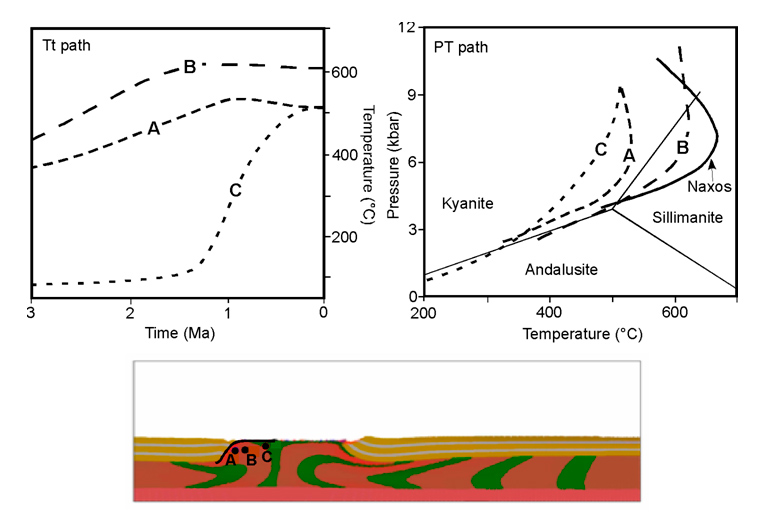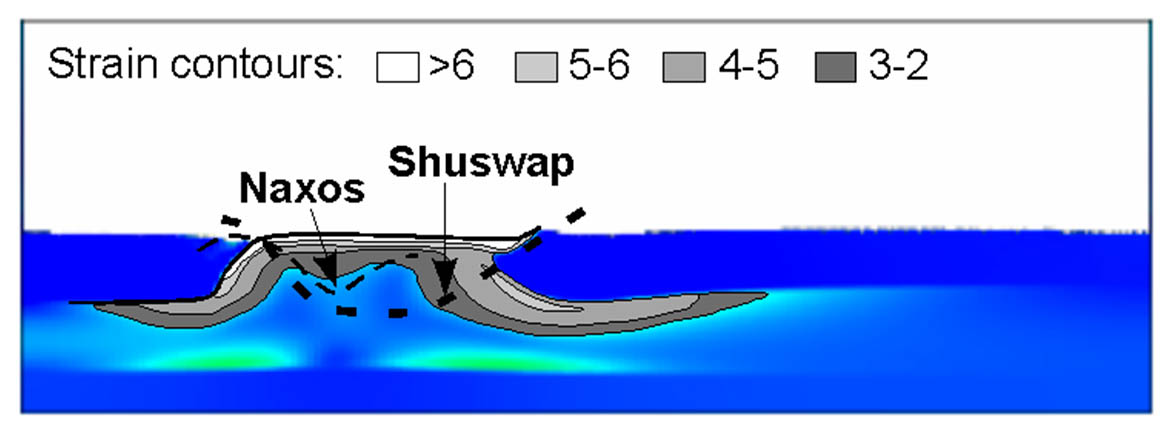Continental extensional tectonics
Continental break-up and the formation of oceanic basins is a fundamental process in Earth Sciences. In controlling continental break-up, extensional tectonics is one of the most fundamental processes that shape the face of our planet. Extension and break-up is key to understanding the evolution of continents, and the origin of sedimentary basins and their hydrocarbon potential, as well as the thermohaline circulation in the oceans and thus global climate. Yet, the mechanisms by which continents split apart are poorly known.
The classic example of large-scale continental extension is the Basin-and-Range province in the western US. Despite the fact that extension across the Basin-and-Range is highly differential with some area recording 300% and other areas almost no extension the Moho across the region is flat (Gans, 1987). This puzzling fact is explained through the general assumption that the lower crust is hot and weak, enabling viscous flow to accommodate horizontal pressure gradients laterally across normal-fault systems (Gans, 1987, Axen et al., 1998). A rheologically weak lower crust may be sufficient to accommodate crustal thickness contrasts, thus leaving the Moho flat across extensional terrains as observed in the Basin-and-Range (Block and Royden, 1990, McKenzie et al., 2000).
During continental extension considerable strain partitioning between the different rheological layers takes place. Deformation partitioning between the upper and the lower crust depends on the efficiency of the lower crustal channel to accommodate strain. In channel flow, the velocity of the flow is proportional to the pressure gradient and the height of the flow channel, and inversely proportional to viscosity (Turcotte and Schubert, 2002). When the lower crustal viscosity is low, a flow channel with a large velocity gradient allows material to fill the space between the segmented upper crust without affecting the upper crust (Fig. 1). If this widely accepted concept is right, then strain in the lower crust should be high (Fig. 2) and this prediction can be tested by field based studies in the footwall of hot, migmatitic core complexes. Such a field-based strain study is warranted to validate the far-reaching assumptions and implications made by theoretical geoscientists.
In low-viscosity (hot and weak) lower plates of core complexes a rapidly flowing lower crust is exhumed from deep crustal levels to the Earth’s surface. Tectonic denudation of the lower plate leads to a modification of the thermal structure by the ductile flow pattern, resulting in a higher geothermal gradient in the center of the metamorphic dome. This indicates that the flow velocity exceeds the thermal diffusivity of the rock, resulting in advection of heat by rapid ductile flow. All numerical simulations suggest cooling rates of the order of hundreds of °C per million years (Block and Royden, 1990, McKenzie et al., 2000, Tikoff et al., 2002). These predictions match the final cooling history of core complexes, which contain partially molten lower plate areas (Miller et al., 1999, Brichau et al., 2006, 2007). More importantly, recent models (e.g. Gessner et al., 2007) predict that PTt paths for tracers located in close proximity to the ductile shear zone are characterized by marked heating during decompression (i.e. the thermal peak occurs as the rocks are transported towards the surface) (Fig. 1). If this theoretical finding can be verified by field data, then viscous flow velocities in the lower crust must exceed the thermal diffusivity of the lower crust. This would result in heat advection to dominate over conductive heat transfer. As a consequence, thermal events occurring in such a setting might be caused by rapid flow of the lower crust instead of the emplacement of magmatic bodies as generally assumed.
Our research on extensional tectonics focuses on the initial stages of continental extension, which are commonly expressed by the development of metamorphic core complex. An important and still not well-understood topic is the nature of metamorphic events associated with lithospheric extension. In many rift settings, extension is also associated with a temperature-dominated metamorphism. A fundamental question is what the mechanism driving this metamorphism is: is it mainly radioactive decay from upper crustal rocks now buried at depth? Or does the asthenospheric mantle play an important role? Closely related to this question is the role of magmatic processes and whether magmatism can trigger extension and associated metamorphism or whether it is a consequence of these processes.
We look at the architecture of metamorphic core complex. A main question is whether the core complexes have a single large-scale normal fault or whether there are two oppositely dipping normal fault systems. In the latter case a major question is how these two fault systems interacted with time. The overall goal of looking at the architecture of core complexes is to decipher whether this architecture is being controlled by the rheology of the ductile crust.
Some of our work in the hangingwalls of major extensional shear zones and faults concerns the roles of pure and simple shear in continental extension. In the asymmetric simple stretching model the asthenosphere rises up in a more focused way than in the pure shear model and consequently the heat flow is less in simple shear rifting. These aspects are important for the thermal evolution of passive margins and their hydrocarbon potential.
The main tools we are using are structural field work, low-temperature geochronology to constrain the timing, amount of slip and slip rates of major extensional detachments, radiometric dating of mylonites, P-T-t path modeling of exhumed mid to lower crustal rocks and numerical modelling.
Field projects addressing the above problems are currently been carried out in the eastern Mediterranean, British Columbia and the South Island of New Zealand.
Collaborators in the projects are Alasdair Skelton (SU), Johannes Glodny (GFZ Potsdam), Klaus Gessner (GSWA Perth), Stuart Thomson (Univ. Arizona), Andy Tulloch (GNS Dunedin).

Fig.1. Temperature-time and pressure-temperature diagrams for extensional exhumation of hot lower crust. Notice very fast cooling for exhumed tracer C and distinctly slower cooling for A and B (left). In contrast, there is a much stronger trend of initial decompression heating in tracers A and B as compared to C (right). Numerical extension model at bottom shows upward flowing lower crust (vertical stripes) between extending upper crust (horizontal stripes) to form core complex; A, B and C are tracers for which Tt and PT histories were computed (redrawn from Gessner at al. 2007, Tectonics).

Fig.2. Contouring of finite strain (values represent second invariant of strain tensor) (simplified from Gessner et al. 2007). Dashed lines approximately show current erosion levels for Naxos (Greece) and Shuswap (British Columbia, Canada) core complexes.
|


